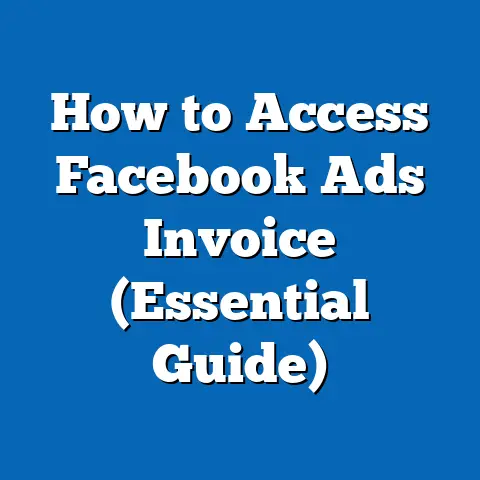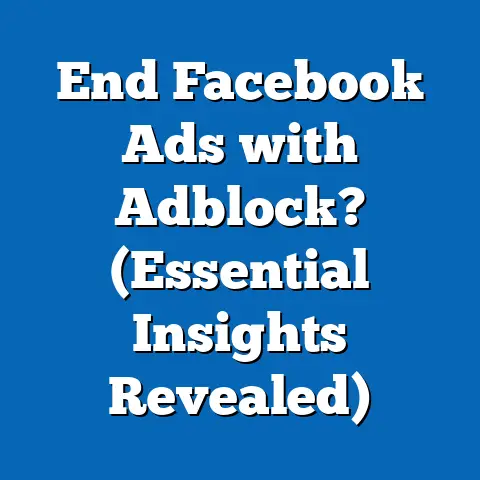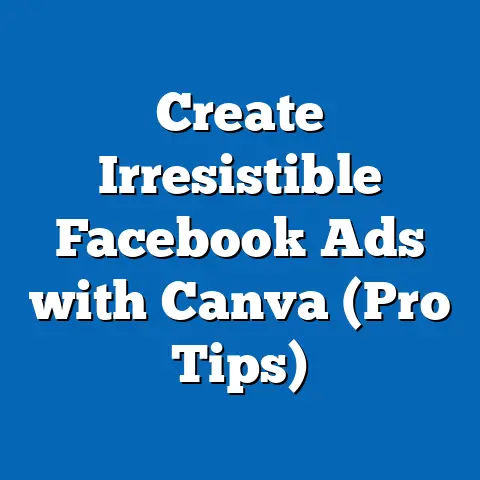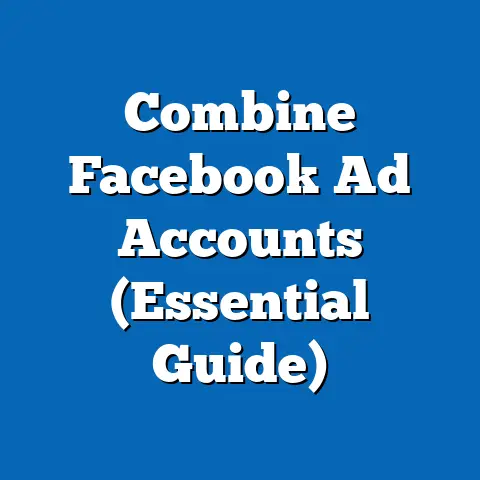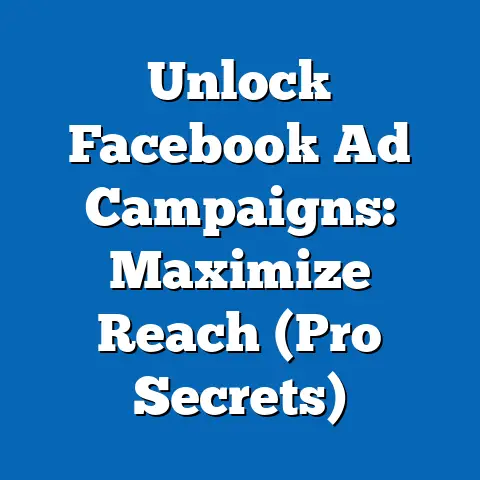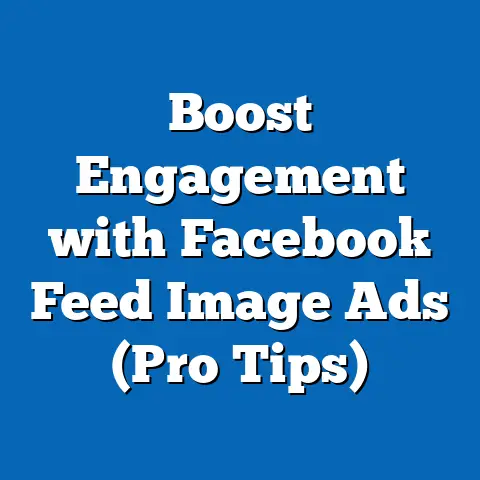Revitalize Facebook Marketplace Ads (Pro Tips Revealed)
In the ever-evolving landscape of online commerce, your Facebook Marketplace ads are not just an option; they are a necessity for survival! I’ve seen businesses of all sizes absolutely explode their sales using the Marketplace, and I’m here to tell you how you can too.
The digital marketplace is a dynamic arena, constantly shifting with new trends and technologies. Among these, Facebook Marketplace has emerged as a powerful platform for businesses to connect with potential customers and drive sales. Its rapid growth and potential for businesses of all sizes make it a vital component of any comprehensive digital advertising strategy. I remember when the Marketplace first launched, it felt like a digital garage sale. Now, it’s a sophisticated e-commerce engine.
This article isn’t just another surface-level guide. I’m going to unveil expert strategies to breathe new life into your Facebook Marketplace ads, making them more effective, more engaging, and ultimately, more lucrative. We’ll dive deep into crafting irresistible listings, mastering targeting, leveraging analytics, building communities, and implementing best practices. Get ready to transform your Marketplace presence from a trickle to a flood of eager buyers.
Why Facebook Marketplace Matters
Before we jump into the nitty-gritty, let’s understand why Facebook Marketplace has become such a game-changer.
- Massive Reach: Facebook boasts billions of active users, and a significant portion of them regularly browse the Marketplace. This provides an unparalleled opportunity to reach a vast and diverse audience.
- Local Focus: The Marketplace is inherently local, connecting buyers and sellers within a specific geographic radius. This is a huge advantage for businesses targeting local customers.
- Ease of Use: Both buyers and sellers find the Marketplace incredibly user-friendly. Listing an item is quick and straightforward, and browsing is intuitive.
- Built-In Trust: Because users are interacting with real profiles and often have mutual connections, there’s a level of trust that’s often missing in other online marketplaces.
- Mobile-First: The Marketplace is optimized for mobile devices, which is crucial in today’s mobile-driven world.
My Own Experience
I remember consulting with a local bakery that was struggling to gain traction. They had a beautiful storefront and delicious products, but their marketing efforts were falling flat. We decided to give Facebook Marketplace a try, focusing on showcasing their daily specials and highlighting seasonal treats. Within weeks, they saw a significant increase in foot traffic and online orders. The Marketplace became their secret weapon for connecting with the local community and driving sales.
Now, let’s get into the details of how you can achieve similar results.
Section 1: Understanding Facebook Marketplace Ads
Understanding Facebook Marketplace ads is crucial before diving into strategies to revitalize them. They’re not just another type of Facebook ad; they have unique characteristics and functionalities that set them apart.
What Are Facebook Marketplace Ads?
Facebook Marketplace ads are listings that appear within the Facebook Marketplace, a platform where users can buy and sell items locally. Unlike traditional Facebook ads that appear in newsfeeds or sidebars, Marketplace ads are specifically designed to target users who are actively looking to purchase products or services. These ads can be either organic listings or paid ads, offering businesses a dual approach to reach potential customers.
The key difference lies in the intent. People go to the Marketplace with the express purpose of buying something. They’re in a shopping mindset, which makes them far more receptive to your offers than someone passively scrolling through their newsfeed.
Demographics and Shopping Behaviors of Marketplace Users
Facebook Marketplace attracts a diverse range of users, but understanding their demographics and shopping behaviors is essential for effective advertising.
- Age: While the platform is popular among all age groups, it particularly resonates with millennials and Gen Xers.
- Location: Marketplace users are geographically diverse, spanning urban, suburban, and rural areas.
- Interests: Users’ interests vary widely, covering everything from electronics and furniture to clothing and automotive parts.
- Shopping Behaviors: Marketplace users are often bargain hunters, seeking deals and discounts. They also value convenience and local availability.
Statistics to Consider:
- According to Facebook, millions of people use Marketplace every month to buy and sell items.
- A significant percentage of Marketplace users are more likely to purchase from local sellers.
- Mobile usage dominates Marketplace activity, with most users accessing the platform via their smartphones.
How the Marketplace Algorithm Affects Visibility
The Facebook Marketplace algorithm plays a critical role in determining the visibility and engagement of your ads. Understanding how it works can help you optimize your listings for maximum exposure.
- Relevance: The algorithm prioritizes listings that are relevant to users’ interests and search queries.
- Location: Local listings are given preference, ensuring that users see items available in their vicinity.
- Listing Quality: High-quality listings with clear images, detailed descriptions, and accurate pricing are favored.
- Seller Reputation: Sellers with positive reviews and ratings are more likely to have their listings displayed prominently.
- Engagement: Listings that generate high levels of engagement, such as clicks, shares, and comments, are rewarded with increased visibility.
Personal Anecdote:
I once worked with a furniture store that was struggling to get their Marketplace listings seen. Their photos were blurry, their descriptions were vague, and their prices were too high. After a complete overhaul – professional photos, detailed descriptions highlighting the craftsmanship, and competitive pricing – their listings shot to the top of the search results, and their sales skyrocketed. It was a direct result of understanding and catering to the algorithm.
Takeaway: To thrive on Facebook Marketplace, you need to understand your audience, optimize your listings, and build a positive reputation. By doing so, you can unlock the platform’s immense potential and drive significant results for your business.
Section 2: Crafting Irresistible Listings
The heart of any successful Facebook Marketplace strategy lies in crafting listings that are simply irresistible. Think of your listing as your digital storefront. It needs to be visually appealing, informative, and persuasive.
The Power of High-Quality Visuals
In the world of online commerce, a picture truly is worth a thousand words. High-quality visuals are essential for capturing attention and enticing potential buyers.
- Photography Tips:
- Use a high-resolution camera or smartphone: Blurry or pixelated images are a major turn-off.
- Shoot in natural light: Natural light enhances colors and textures, making your products look more appealing.
- Use a clean background: A cluttered background can distract from the product.
- Showcase multiple angles: Provide a comprehensive view of the product from different perspectives.
- Include lifestyle shots: Show the product in use to help buyers visualize owning it.
- Lighting Techniques:
- Avoid harsh shadows: Use diffusers or softboxes to soften the light.
- Use reflectors: Reflectors can bounce light onto the product, filling in shadows and adding brightness.
- Experiment with different lighting angles: Different angles can create different moods and highlight different features.
- Staging Your Products:
- Create a visually appealing setting: Stage your products in a way that complements their style and function.
- Use props to add context: Props can help buyers understand the size and scale of the product.
- Keep it clean and organized: A cluttered or messy setting can detract from the product.
- Use a high-resolution camera or smartphone: Blurry or pixelated images are a major turn-off.
- Shoot in natural light: Natural light enhances colors and textures, making your products look more appealing.
- Use a clean background: A cluttered background can distract from the product.
- Showcase multiple angles: Provide a comprehensive view of the product from different perspectives.
- Include lifestyle shots: Show the product in use to help buyers visualize owning it.
- Avoid harsh shadows: Use diffusers or softboxes to soften the light.
- Use reflectors: Reflectors can bounce light onto the product, filling in shadows and adding brightness.
- Experiment with different lighting angles: Different angles can create different moods and highlight different features.
- Create a visually appealing setting: Stage your products in a way that complements their style and function.
- Use props to add context: Props can help buyers understand the size and scale of the product.
- Keep it clean and organized: A cluttered or messy setting can detract from the product.
Writing Compelling Product Descriptions
While visuals are crucial, compelling product descriptions are equally important for providing detailed information and persuading buyers to take action.
Instead of saying “Used iPhone 13,” try something like:
“Like-New iPhone 13 – Unleash the Power of a Pro! ✨ This stunning iPhone 13 is in pristine condition, with a crystal-clear display, lightning-fast A15 Bionic chip, and a camera that captures breathtaking photos and videos. It’s unlocked and ready for your SIM card. Grab this incredible deal before it’s gone! ➡️ Message me now to arrange a pickup!”
The Role of Pricing Strategies
Pricing is a critical factor in determining the success of your Marketplace listings. A well-thought-out pricing strategy can attract buyers and maximize your profits.
- Competitive Pricing: Research similar products on the Marketplace and price your items competitively.
- Psychological Pricing: Use techniques like pricing items at \$9.99 instead of \$10 to create the illusion of a lower price.
- Discounts and Promotions: Offer discounts and promotions to incentivize buyers and drive sales.
- Bundle Pricing: Bundle related products together and offer them at a discounted price.
- Negotiation: Be open to negotiation, especially for higher-priced items.
My Biggest Mistake (and What I Learned):
Early in my career, I was helping a client sell vintage clothing on the Marketplace. We priced everything based on what we thought it was worth, completely ignoring the competition. Needless to say, sales were abysmal. Once we did a thorough market analysis and adjusted our prices to be more competitive, sales took off. The lesson? Your perception of value doesn’t matter as much as the market’s.
Takeaway: Crafting irresistible listings is a multifaceted process that requires attention to detail and a deep understanding of your target audience. By focusing on high-quality visuals, compelling descriptions, and strategic pricing, you can create listings that stand out from the crowd and drive sales.
Section 3: Targeting and Audience Segmentation
You’ve got a killer listing, but it’s useless if it’s not seen by the right people. Targeting is the art of connecting your product with the buyers who are most likely to be interested.
The Importance of Audience Targeting
Audience targeting is the process of identifying and reaching specific groups of people who are most likely to be interested in your products or services. By targeting the right audience, you can increase the effectiveness of your ads and maximize your ROI.
- Relevance: Targeted ads are more relevant to users, leading to higher engagement rates.
- Efficiency: Targeting reduces wasted ad spend by focusing on users who are most likely to convert.
- Personalization: Targeting allows you to personalize your ads, tailoring your message to specific audience segments.
- ROI: By targeting the right audience, you can generate more leads, sales, and revenue.
Leveraging Facebook’s Targeting Options
Facebook offers a wide range of targeting options that allow you to reach specific audience segments based on their demographics, interests, and behaviors.
- Demographics: Target users based on age, gender, location, education, and relationship status.
- Interests: Target users based on their interests, hobbies, and passions.
- Behaviors: Target users based on their online behaviors, such as purchase history, website visits, and app usage.
- Connections: Target users who are connected to your Facebook page or have interacted with your ads.
Creating Custom and Lookalike Audiences
In addition to Facebook’s built-in targeting options, you can also create custom and lookalike audiences to reach even more specific groups of people.
- Custom Audiences: Create custom audiences based on your existing customer data, such as email lists, phone numbers, and website visitors.
- Lookalike Audiences: Create lookalike audiences based on your custom audiences, targeting users who share similar characteristics and behaviors.
How to Create a Custom Audience:
- Go to Facebook Ads Manager.
- Click on “Audiences.”
- Click on “Create Audience” and select “Custom Audience.”
- Choose your source (e.g., customer list, website traffic).
- Follow the instructions to upload your data or connect your website.
How to Create a Lookalike Audience:
- Go to Facebook Ads Manager.
- Click on “Audiences.”
- Select your custom audience.
- Click on “Create Audience” and select “Lookalike Audience.”
- Choose your source audience, location, and audience size.
A/B Testing Your Audience Segments
A/B testing is the process of comparing two or more versions of your ads to see which one performs better. By A/B testing your audience segments, you can identify the most responsive groups and optimize your targeting strategy.
- Create Multiple Ad Sets: Create multiple ad sets, each targeting a different audience segment.
- Run Your Ads Simultaneously: Run your ads simultaneously to ensure that they are exposed to the same market conditions.
- Track Your Results: Track your results using Facebook Insights and Analytics to see which audience segments are performing best.
- Optimize Your Targeting: Based on your results, optimize your targeting strategy by focusing on the most responsive audience segments.
Real-World Example:
A local gym was struggling to attract new members. They were running generic ads targeting everyone in the city. We decided to segment their audience based on interests – fitness enthusiasts, yoga lovers, and weightlifters. We then created targeted ads that spoke directly to each group’s specific needs and goals. The results were dramatic, with a significant increase in leads and new memberships.
Takeaway: Effective audience targeting is the cornerstone of a successful Facebook Marketplace advertising strategy. By leveraging Facebook’s targeting options, creating custom and lookalike audiences, and A/B testing your audience segments, you can connect with the right buyers and maximize your ROI.
Section 4: Utilizing Facebook Insights and Analytics
Data is the lifeblood of any successful marketing campaign. Facebook Insights and Analytics provide a wealth of information about your ad performance, allowing you to make data-driven decisions and optimize your strategy for maximum impact.
The Importance of Facebook Insights
Facebook Insights is a powerful tool that provides valuable data about your audience, your content, and your overall performance on Facebook.
- Audience Insights: Understand your audience’s demographics, interests, and behaviors.
- Content Insights: See which types of content are resonating with your audience.
- Performance Insights: Track your key metrics, such as impressions, clicks, and conversion rates.
- Benchmarking: Compare your performance to industry benchmarks and identify areas for improvement.
Key Metrics to Monitor
There are several key metrics that you should monitor regularly to track the performance of your Facebook Marketplace ads.
- Impressions: The number of times your ad is displayed to users.
- Reach: The number of unique users who have seen your ad.
- Clicks: The number of times users have clicked on your ad.
- Click-Through Rate (CTR): The percentage of users who have clicked on your ad after seeing it.
- Conversion Rate: The percentage of users who have completed a desired action, such as making a purchase or filling out a form.
- Cost Per Click (CPC): The average cost you pay for each click on your ad.
- Cost Per Acquisition (CPA): The average cost you pay for each conversion.
- Return on Ad Spend (ROAS): The amount of revenue you generate for every dollar you spend on advertising.
Formulas to Remember:
- CTR = (Clicks / Impressions) x 100
- Conversion Rate = (Conversions / Clicks) x 100
- ROAS = (Revenue / Ad Spend)
Interpreting Metrics for Ad Optimization
Interpreting your metrics is essential for making data-driven decisions and optimizing your ad strategy.
- High Impressions, Low Clicks: This indicates that your ad is being seen by a lot of people, but it’s not compelling enough to make them click. Try improving your visuals, headline, or description.
- High Clicks, Low Conversions: This indicates that your ad is attracting clicks, but your landing page or product page is not converting visitors into customers. Try improving your landing page design, product descriptions, or pricing.
- Low Impressions, High Engagement: This indicates that your ad is highly engaging, but it’s not being seen by enough people. Try expanding your targeting or increasing your budget.
- High CPC, Low Conversions: This indicates that you’re paying too much for each click, and your ads are not generating enough conversions to justify the cost. Try refining your targeting, improving your ad quality, or lowering your bids.
My ‘Aha!’ Moment:
I was managing a campaign for an e-commerce store that was selling handmade jewelry. We were getting a decent number of clicks, but the conversion rate was abysmal. After digging into the data, I realized that most of the clicks were coming from mobile users, but the website wasn’t optimized for mobile devices. Once we made the website mobile-friendly, the conversion rate skyrocketed. It was a powerful reminder that data can reveal hidden opportunities for improvement.
Adjusting Ad Strategies Based on Performance Data
Based on your performance data, you can adjust your ad strategies to improve your results.
- Refine Your Targeting: Focus on the audience segments that are performing best and exclude the ones that are not.
- Improve Your Ad Creative: Test different visuals, headlines, and descriptions to see which ones resonate best with your audience.
- Adjust Your Bids: Increase your bids for high-performing ads and lower your bids for low-performing ads.
- Optimize Your Landing Page: Make sure your landing page is relevant to your ad and optimized for conversions.
- Experiment with Different Ad Formats: Try different ad formats, such as image ads, video ads, and carousel ads, to see which ones perform best.
Takeaway: Facebook Insights and Analytics are your secret weapons for unlocking the full potential of your Marketplace ads. By monitoring your metrics, interpreting your data, and adjusting your strategies accordingly, you can continuously improve your performance and drive significant results for your business.
Section 5: Enhancing Engagement Through Community Building
Facebook is, at its core, a social platform. Building a community around your brand on Facebook can significantly enhance engagement and drive sales on the Marketplace.
The Importance of Building a Community
Building a community around your brand on Facebook can create a loyal following of customers who are passionate about your products or services.
- Increased Engagement: Community members are more likely to engage with your content, share your posts, and leave comments.
- Brand Loyalty: Community members are more likely to become loyal customers who make repeat purchases.
- Word-of-Mouth Marketing: Community members are more likely to recommend your brand to their friends and family.
- Valuable Feedback: Community members can provide valuable feedback about your products, services, and marketing efforts.
Engaging Potential Customers
There are several ways to engage potential customers on Facebook and build a thriving community.
- Respond to Comments and Messages: Respond promptly and thoughtfully to comments and messages from potential customers.
- Ask Questions: Ask questions to encourage engagement and start conversations.
- Run Contests and Giveaways: Run contests and giveaways to attract new followers and reward existing ones.
- Share User-Generated Content: Share user-generated content, such as photos and videos, to showcase your products and services in action.
- Create a Facebook Group: Create a Facebook group where customers can connect with each other, share their experiences, and ask questions.
The Benefits of User-Generated Content and Testimonials
User-generated content (UGC) and testimonials are powerful tools for boosting credibility and trust on Facebook Marketplace.
- Authenticity: UGC and testimonials are seen as more authentic than traditional advertising.
- Social Proof: UGC and testimonials provide social proof that your products and services are valuable.
- Increased Engagement: UGC and testimonials can generate high levels of engagement, as users are more likely to trust the opinions of their peers.
- Improved Conversion Rates: UGC and testimonials can improve conversion rates by building trust and confidence in your brand.
How to Encourage UGC:
- Ask for Reviews: Encourage customers to leave reviews on your Facebook page.
- Run a Photo Contest: Ask customers to submit photos of themselves using your products.
- Create a Hashtag: Create a hashtag for your brand and encourage customers to use it when sharing photos and videos.
- Feature Customers on Your Page: Feature customers on your page and share their stories.
Understanding Social Proof
Social proof is the psychological phenomenon where people are more likely to take action if they see that others have already done so. On Facebook Marketplace, social proof can take many forms, such as positive reviews, high ratings, and a large number of followers.
- Reviews and Ratings: Positive reviews and high ratings can build trust and confidence in your brand.
- Follower Count: A large number of followers can indicate that your brand is popular and trustworthy.
- Likes and Shares: A high number of likes and shares can indicate that your content is engaging and valuable.
- Comments and Mentions: Positive comments and mentions can build trust and credibility.
Takeaway: Building a community around your brand on Facebook is a long-term investment that can pay off in increased engagement, brand loyalty, and sales. By engaging with potential customers, leveraging user-generated content and testimonials, and understanding the power of social proof, you can create a thriving community that drives results for your business.
Section 6: Best Practices for Running Facebook Marketplace Ads
Running effective Facebook Marketplace ads requires a strategic approach and adherence to best practices. Here’s a compilation of tips and insights to help you maximize your ad performance.
Frequency, Timing, and Ad Format
- Frequency: Don’t bombard users with too many ads. A good rule of thumb is to show your ads to the same user no more than 2-3 times per week.
- Timing: Consider the time of day and day of week when your target audience is most likely to be online and engaged.
- Ad Format: Experiment with different ad formats, such as image ads, video ads, and carousel ads, to see which ones perform best for your products and services.
Common Pitfalls to Avoid
- Poor Quality Images: Avoid using blurry, pixelated, or poorly lit images.
- Vague Descriptions: Provide detailed and accurate descriptions of your products.
- Inaccurate Pricing: Make sure your pricing is competitive and accurate.
- Ignoring Customer Inquiries: Respond promptly and thoughtfully to customer inquiries.
- Violating Facebook’s Policies: Familiarize yourself with Facebook’s advertising policies and avoid violating them.
Staying Compliant with Facebook’s Advertising Policies
Facebook has strict advertising policies that all advertisers must adhere to. Violating these policies can result in ad disapprovals, account suspensions, or even permanent bans.
- Prohibited Content: Facebook prohibits ads that promote illegal products or services, discrimination, hate speech, violence, or other harmful content.
- Misleading Claims: Avoid making false or misleading claims about your products or services.
- Copyright Infringement: Do not use copyrighted images, videos, or text without permission.
- Data Privacy: Respect users’ data privacy and comply with all applicable data privacy laws.
My Biggest Policy Scare:
I once had an ad for a weight loss product rejected because it violated Facebook’s policy against making unrealistic claims. Even though the product was legitimate and had positive reviews, Facebook flagged the ad because it promised “guaranteed results.” I learned a valuable lesson about the importance of carefully reviewing Facebook’s policies and avoiding any language that could be considered misleading or deceptive.
Capitalizing on Seasonal Trends
Seasonal trends can provide a significant boost to your Marketplace ad campaigns.
- Holidays: Run special promotions and discounts during major holidays, such as Christmas, Thanksgiving, and Valentine’s Day.
- Seasons: Adjust your product offerings and messaging to reflect the changing seasons.
- Events: Capitalize on local events and festivals by running targeted ads.
- Back-to-School: Target parents and students with ads for school supplies, clothing, and electronics during the back-to-school season.
Takeaway: Running effective Facebook Marketplace ads requires a combination of strategy, creativity, and attention to detail. By following these best practices, avoiding common pitfalls, and staying compliant with Facebook’s advertising policies, you can maximize your ad performance and drive significant results for your business.
Conclusion
We’ve covered a lot of ground in this guide, from understanding the basics of Facebook Marketplace ads to implementing advanced strategies for optimization and engagement. The key takeaways are clear:
- Optimize your listings: High-quality visuals, compelling descriptions, and strategic pricing are essential for attracting buyers.
- Target the right audience: Use Facebook’s targeting options, create custom and lookalike audiences, and A/B test your audience segments.
- Leverage data: Monitor your metrics, interpret your data, and adjust your strategies accordingly.
- Build a community: Engage with potential customers, leverage user-generated content and testimonials, and understand the power of social proof.
- Follow best practices: Adhere to best practices for frequency, timing, and ad format, avoid common pitfalls, and stay compliant with Facebook’s advertising policies.
Now, it’s time to put these strategies into action. I encourage you to experiment with your Marketplace ads, try new approaches, and continuously optimize your campaigns based on your results. The potential of Facebook Marketplace is immense, and with the right strategies, you can unlock its full power and drive significant growth for your business.
So, what are you waiting for? Revitalize your Facebook Marketplace ads today and unleash the power of this incredible platform! Go forth and conquer the Marketplace!

